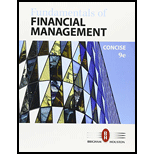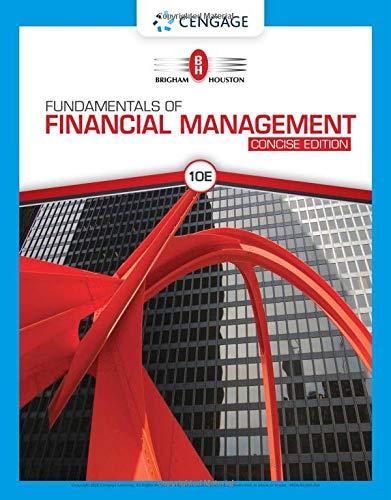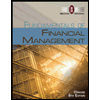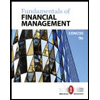
Fundamentals of Financial Management, Concise Edition
9th Edition
ISBN: 9781337087544
Author: Eugene F. Brigham, Joel F. Houston
Publisher: Cengage Learning
expand_more
expand_more
format_list_bulleted
Question
Chapter 9, Problem 4DQ
Summary Introduction
To explain: Whether the P/E ratio of the company is well above or well below its latest 5-year average, the reason of P/E ratio of the given company deviates from its historical trend, and whether the stock prices of the given company is undervalued or overvalued on the basis of its P/E ratio.
Introduction:
Profit Earning Ratio (P/E Ratio): It refers to the ratio between the price of a share of the company and the earnings on that share, which is earning per share of the company. In other words, it can be defined as the ratio between the price per share of the company and its earnings per share.
Expert Solution & Answer
Want to see the full answer?
Check out a sample textbook solution
Students have asked these similar questions
Crenshaw, Incorporated, is considering the purchase of a $367,000 computer with an economic life of five years. The computer will be
fully depreciated over five years using the straight-line method. The market value of the computer will be $67,000 in five years. The
computer will replace five office employees whose combined annual salaries are $112,000. The machine will also immediately lower
the firm's required net working capital by $87,000. This amount of net working capital will need to be replaced once the machine is
sold. The corporate tax rate is 22 percent. The appropriate discount rate is 15 percent. Calculate the NPV of this project.
Note: Do not round intermediate calculations and round your answer to 2 decimal places, e.g., 32.16.
NPV
Answer is complete but not entirely correct.
S 103,141.80
Your firm is contemplating the purchase of a new $610,000 computer-based order entry system. The system will be depreciated
straight-line to zero over its five-year life. It will be worth $66,000 at the end of that time. You will save $240,000 before taxes per year
in order processing costs, and you will be able to reduce working capital by $81,000 (this is a one-time reduction). If the tax rate is 21
percent, what is the IRR for this project?
Note: Do not round intermediate calculations and enter your answer as a percent rounded to 2 decimal places, e.g., 32.16.
IRR
%
QUESTION 1
Examine the information provided below and answer the following question.
(10 MARKS)
The hockey stick model of start-up financing, illustrated by the diagram below, has received a lot of attention in the
entrepreneurial finance literature (Cumming & Johan, 2013; Kaplan & Strömberg, 2014; Gompers & Lerner, 2020). The model
is often used to describe the typical funding and growth trajectory of many startups. The model emphasizes three main
stages, each of which reflects a different phase of growth, risk, and funding expectations.
Entrepreneur, 3 F's
Debt(banks & microfinance)
Research Business angels/Angel Venture funds/Venture capitalists
Merger, Acquisition
Grants
investors
PO
Public market
Growth (revenue)
Break even
point
Pide
1st round
Expansion
2nd round
3rd round
Research
commercial idea
Pre-seed
Initial concept
Seed
Early
Expansion
Financial stage
Late
IPO
Inception and
prototype
Figure 1. The hockey stick model of start-up financing (Lasrado & Lugmayr, 2013)
REQUIRED:…
Chapter 9 Solutions
Fundamentals of Financial Management, Concise Edition
Ch. 9.A - For a stock to be in equilibrium, what two...Ch. 9.A - If a stock is not in equilibrium, explain how...Ch. 9.A - RATES OF RETURN AND EQUILIBRIUM Stock Cs beta...Ch. 9.A - Prob. 2PCh. 9.A - Prob. 3PCh. 9 - It is frequently stated that the one purpose of...Ch. 9 - Is the following equation correct for finding the...Ch. 9 - Prob. 3QCh. 9 - Two investors are evaluating GEs stock for...Ch. 9 - A bond that pays interest forever and has no...
Ch. 9 - Discuss the similarities and differences between...Ch. 9 - This chapter discusses the discounted dividend and...Ch. 9 - DPS CALCULATION Weston Corporation just paid a...Ch. 9 - CONSTANT GROWTH VALUATION Tresnan Brothers is...Ch. 9 - CONSTANT GROWTH VALUATION Holtzman Clothierss...Ch. 9 - NONCONSTANT GROWTH VALUATION Holt Enterprises...Ch. 9 - CORPORATE VALUATION Scampini Technologies is...Ch. 9 - PREFERRED STOCK VALUATION Farley Inc. has...Ch. 9 - Prob. 7PCh. 9 - PREFERRED STOCK VALUATION Earley Corporation...Ch. 9 - PREFERRED STOCK RETURNS Avondale Aeronautics has...Ch. 9 - VALUATION OF A DECLINING GROWTH STOCK Maxwell...Ch. 9 - Suppose you believe that the economy is just...Ch. 9 - Prob. 12PCh. 9 - CONSTANT GROWTH You are considering an investment...Ch. 9 - NONCONSTANT GROWTH Computech Corporation is...Ch. 9 - Prob. 15PCh. 9 - NONCONSTANT GROWTH Carnes Cosmetics Co.s stock...Ch. 9 - CONSTANT GROWTH Your broker offers to sell you...Ch. 9 - NONCONSTANT GROWTH STOCK VALUATION Taussig...Ch. 9 - Prob. 19PCh. 9 - Prob. 20PCh. 9 - NONCONSTANT GROWTH Assume that it is now January...Ch. 9 - Comprehensive/Spreadsheet Problem NONCONSTANT...Ch. 9 - Prob. 23ICCh. 9 - Prob. 1DQCh. 9 - Prob. 2DQCh. 9 - Prob. 3DQCh. 9 - Prob. 4DQCh. 9 - Prob. 5DQCh. 9 - Prob. 6DQCh. 9 - The required return on equity, rs, is the final...Ch. 9 - Prob. 8DQCh. 9 - Prob. 9DQCh. 9 - Prob. 10DQ
Knowledge Booster
Similar questions
- critically discuss the hockey stick model of a start-up financing. In your response, explain the model and discibe its three main stages, highlighting the key characteristics of each stage in terms of growth, risk, and funding expectations.arrow_forwardSolve this problem please .arrow_forwardSolve this finance question.arrow_forward
- solve this question.Pat and Chris have identical interest-bearing bank accounts that pay them $15 interest per year. Pat leaves the $15 in the account each year, while Chris takes the $15 home to a jar and never spends any of it. After five years, who has more money?arrow_forwardWhat is corporate finance? explain all thingsarrow_forwardSolve this finance problem.arrow_forward
arrow_back_ios
SEE MORE QUESTIONS
arrow_forward_ios
Recommended textbooks for you
 Fundamentals Of Financial Management, Concise Edi...FinanceISBN:9781337902571Author:Eugene F. Brigham, Joel F. HoustonPublisher:Cengage Learning
Fundamentals Of Financial Management, Concise Edi...FinanceISBN:9781337902571Author:Eugene F. Brigham, Joel F. HoustonPublisher:Cengage Learning Fundamentals of Financial Management, Concise Edi...FinanceISBN:9781285065137Author:Eugene F. Brigham, Joel F. HoustonPublisher:Cengage Learning
Fundamentals of Financial Management, Concise Edi...FinanceISBN:9781285065137Author:Eugene F. Brigham, Joel F. HoustonPublisher:Cengage Learning Fundamentals of Financial Management, Concise Edi...FinanceISBN:9781305635937Author:Eugene F. Brigham, Joel F. HoustonPublisher:Cengage Learning
Fundamentals of Financial Management, Concise Edi...FinanceISBN:9781305635937Author:Eugene F. Brigham, Joel F. HoustonPublisher:Cengage Learning

Fundamentals Of Financial Management, Concise Edi...
Finance
ISBN:9781337902571
Author:Eugene F. Brigham, Joel F. Houston
Publisher:Cengage Learning

Fundamentals of Financial Management, Concise Edi...
Finance
ISBN:9781285065137
Author:Eugene F. Brigham, Joel F. Houston
Publisher:Cengage Learning

Fundamentals of Financial Management, Concise Edi...
Finance
ISBN:9781305635937
Author:Eugene F. Brigham, Joel F. Houston
Publisher:Cengage Learning